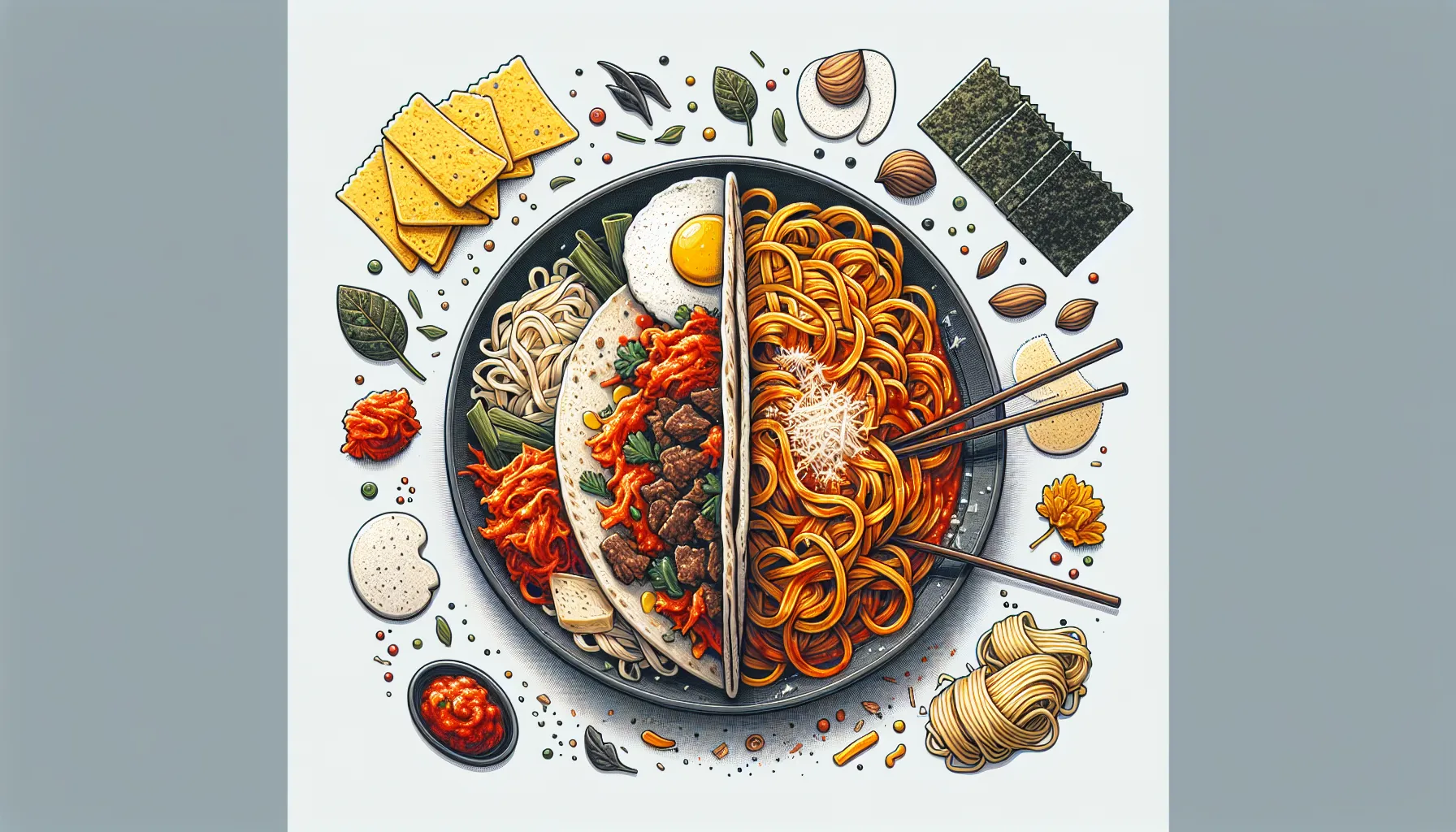Globalization’s impact on traditional food industries is a topic that has appeared in IELTS Writing Task 2 several times in recent years. Its frequency suggests it may continue to be a relevant subject for future exams. Based on past trends, we can expect questions related to the preservation of culinary traditions, the influence of international cuisines, and the economic effects on local food businesses. Let’s examine a sample question that encapsulates these themes:
Some people believe that the increasing availability of international cuisines in many countries is leading to a loss of traditional cooking methods and dishes. To what extent do you agree or disagree with this opinion?
Analysis of the Question
This question requires candidates to consider the relationship between globalization and traditional food cultures. Key points to address include:
- The impact of international cuisines on local food traditions
- The potential loss of traditional cooking methods and dishes
- The extent to which the candidate agrees or disagrees with the statement
- Reasons and examples to support the argument
Sample Essay 1 (Band 8-9)
The globalization of cuisine has undoubtedly transformed food landscapes worldwide, leading some to argue that traditional cooking methods and dishes are at risk of disappearing. While I acknowledge the significant influence of international foods, I disagree with the notion that this necessarily results in the loss of culinary heritage.
Firstly, it is true that the proliferation of international restaurants and food products has changed eating habits in many countries. This exposure to global flavors has undeniably altered consumer preferences and expectations. However, rather than obliterating traditional foods, this trend often sparks a renewed interest in local culinary heritage.
Moreover, the interaction between global and local cuisines frequently leads to innovation rather than extinction.  Fusion Cuisine Example Fusion cuisine, which blends elements from different culinary traditions, is a prime example of how globalization can enrich rather than diminish food culture. For instance, the popular Korean-Mexican fusion dishes in the United States demonstrate how traditional ingredients and techniques can be reimagined in exciting new ways.
Fusion Cuisine Example Fusion cuisine, which blends elements from different culinary traditions, is a prime example of how globalization can enrich rather than diminish food culture. For instance, the popular Korean-Mexican fusion dishes in the United States demonstrate how traditional ingredients and techniques can be reimagined in exciting new ways.
Furthermore, the threat of losing traditional foods has galvanized efforts to preserve culinary heritage. Many countries have initiated programs to document and promote traditional recipes and cooking methods.
In conclusion, while the global exchange of culinary ideas has certainly impacted local food scenes, it has not necessarily led to the loss of traditional cooking. Instead, it has often resulted in a dynamic interplay between old and new, preserving tradition while fostering innovation. The key lies in maintaining a balance that allows both international and local cuisines to thrive side by side.
(Word count: 295)
Sample Essay 2 (Band 6-7)
In today’s world, we can see many international restaurants in different countries. Some people think this is causing traditional cooking to disappear. I partly agree with this idea, but I also think there are ways to keep traditional food alive.
It’s true that international food is becoming more popular. In big cities, we can easily find pizza, sushi, or burgers.  Young People Enjoying International Cuisine Many young people prefer these foods because they seem modern and exciting. This might mean they eat less traditional food from their own country. For example, in Vietnam, some young people in cities eat more fast food and less traditional Vietnamese dishes.
Young People Enjoying International Cuisine Many young people prefer these foods because they seem modern and exciting. This might mean they eat less traditional food from their own country. For example, in Vietnam, some young people in cities eat more fast food and less traditional Vietnamese dishes.
However, I don’t think traditional cooking will completely disappear. Many people still love their country’s traditional food and cook it at home. Also, tourists often want to try local dishes when they visit a country, which helps keep these foods popular. For instance, when people visit Thailand, they usually want to try Thai curries and noodles.
Moreover, some chefs are finding ways to mix traditional and international cooking. They use local ingredients to make new dishes that are both modern and traditional. This can help keep old cooking methods alive while making them interesting for younger people.
In conclusion, while international food is becoming more common, I believe traditional cooking can survive if people make an effort to preserve it. It’s important for countries to promote their traditional dishes and for families to continue cooking them at home. This way, we can enjoy both international and traditional foods.
(Word count: 253)
Sample Essay 3 (Band 5-6)
Nowadays, we can see many foreign restaurants in our countries. Some people think this is making traditional cooking disappear. I think this is partly true, but not completely.
It’s true that many people like to eat foreign food now. Young people often prefer these foods because they think they are cool. This means they might not eat traditional food as much as before. For example, in my city, there are more pizza shops now than before.
But I don’t think traditional food will go away completely. Many people still like to eat traditional food at home. Also, when tourists come to a country, they want to try the local food. This helps keep traditional food popular. In my country, tourists always want to try our traditional noodles.
Some chefs are also trying to mix traditional and foreign cooking. They make new dishes that use local ingredients but cook them in new ways. This can make traditional food more interesting for young people.
In conclusion, I think foreign food is becoming more popular, but traditional food is still important. We should try to keep cooking our traditional dishes so they don’t disappear. It’s good to enjoy both foreign and traditional food.
(Word count: 206)
Explanation of Band Scores
Band 8-9 Essay:
- Task Response: Fully addresses all parts of the task with a clear position, well-developed ideas, and relevant examples.
- Coherence and Cohesion: Logically organized with a clear progression of ideas. Uses a range of cohesive devices effectively.
- Lexical Resource: Uses a wide range of vocabulary with very natural and sophisticated control of lexical features.
- Grammatical Range and Accuracy: Uses a wide range of structures with full flexibility and accuracy.
Band 6-7 Essay:
- Task Response: Addresses all parts of the task, though some parts may be more fully covered than others.
- Coherence and Cohesion: Arranges information coherently and there is a clear overall progression. Uses cohesive devices but may be overused or underused.
- Lexical Resource: Uses an adequate range of vocabulary for the task. There may be some errors in word choice but meaning is generally clear.
- Grammatical Range and Accuracy: Uses a mix of simple and complex sentence forms. Makes some errors in grammar and punctuation but they rarely reduce communication.
Band 5-6 Essay:
- Task Response: Addresses the task only partially. The format may be inappropriate in places.
- Coherence and Cohesion: Presents information with some organization but there may be a lack of overall progression. Uses some basic cohesive devices.
- Lexical Resource: Uses a limited range of vocabulary, but this is minimally adequate for the task. May make noticeable errors in spelling and word formation.
- Grammatical Range and Accuracy: Uses only a limited range of structures. Attempts complex sentences but these tend to be less accurate than simple sentences.
Key Vocabulary to Remember
-
Globalization (noun) /ˌɡləʊbəlaɪˈzeɪʃən/ – The process by which businesses or other organizations develop international influence or start operating on an international scale.
-
Culinary (adjective) /ˈkʌlɪnəri/ – Related to cooking or kitchens.
-
Heritage (noun) /ˈherɪtɪdʒ/ – Valued objects and qualities such as cultural traditions that have been passed down from previous generations.
-
Proliferation (noun) /prəˌlɪfəˈreɪʃən/ – Rapid increase in the number or amount of something.
-
Fusion (noun) /ˈfjuːʒən/ – The process or result of joining two or more things together to form a single entity.
-
Galvanize (verb) /ˈɡælvənaɪz/ – Shock or excite (someone) into taking action.
-
Indigenous (adjective) /ɪnˈdɪdʒɪnəs/ – Originating or occurring naturally in a particular place; native.
-
Preservation (noun) /ˌprezəˈveɪʃən/ – The action of preserving something.
-
Innovative (adjective) /ˈɪnəvətɪv/ – Featuring new methods; advanced and original.
-
Authenticity (noun) /ˌɔːθenˈtɪsəti/ – The quality of being authentic or genuine.
In conclusion, the impact of globalization on traditional food industries is a complex and nuanced topic that is likely to remain relevant in IELTS Writing Task 2. Future questions might explore themes such as the role of technology in preserving culinary traditions, the economic impact of global food trends on local producers, or the cultural significance of maintaining traditional cuisines in a globalized world. To prepare, practice writing essays on related topics such as:
- The benefits and drawbacks of food tourism on local culinary traditions
- The role of government in protecting traditional food industries from global competition
- The impact of social media on the popularity of traditional versus international cuisines
Remember to practice writing your own essays on this topic and share them in the comments section below. This active engagement will help you improve your writing skills and prepare effectively for the IELTS exam.
To further explore related topics, you might find these articles helpful:
- The Impact of Globalization on Local Crafts and Industries
- The Role of Arts and Culture in National Identity
- How E-commerce Affects Employment Opportunities
These resources can provide additional context and vocabulary to enhance your understanding of globalization’s effects on various aspects of society, including traditional industries and cultural practices.



